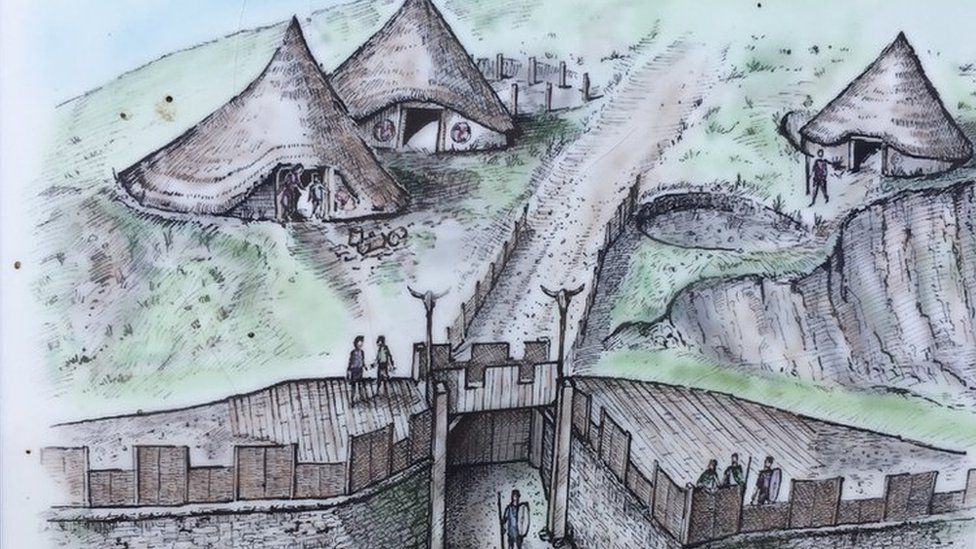Aberystwyth residents help archaeologists excavate Pen Dinas hillfort
- Published

Up to 60 local volunteers have been helping archaeologists excavate an iron age fort site dating back to 400 BC.
For three weeks Dyfed Archaeological Trust has been working on Pen Dinas hillfort in Aberystwyth, Ceredigion after receiving funding from Cadw.
Archaeologists have made a number of finds including an amber bead and stone wheel thought to be a spindle whorl for weaving.
It is only the second time in its history the site has been excavated.
Leading the excavation in the village of Penparcau, Fran Murphy said: "I think they'd been lost - they were found on a hut platform where someone lived and they'd probably fallen through beneath the floor if you like.
"The amber is quite a rare find and the person whoever lost these objects would have been quite annoyed."
She said it was difficult to give a date for the objects but it may be possible in time: "I hope that by the end of this project we will be able to get radiocarbon dating, which should give us a much more precise date, but over 2,000 years old."
Pen Dinas is the largest iron age hillfort in Ceredigion.
At 60ft (18m) the most obvious monument on Pen Dinas is the Wellington Monument, a column built in the 1850s as a memorial to the Duke of Wellington.
In its heyday, more than 2,000 years ago, the huge fort covered an area of 3.5 hectares, the equivalent of about three and a half rugby pitches.
Ms Murphy said: "It's such an enormous monument - and the work that went into creating it was all done by humans with hand tools, no JCB's or mechanical diggers here.
"It's an asset for the whole of Aberystwyth."
She said she would like more people to be able to enjoy it: "I think if we could improve the access, if we can improve the signage to make people aware how accessible it can be, and to bring people up here to look around them and see how it's a part of the history that makes Aberystwyth and the surrounding area what it is."
The National Monuments Record of Wales says the Pen Dinas hillfort "started life as a simple defended site on the north summit [of Pen Dinas hill]".
It said the site was developed over time and, at its height, was "a masterpiece of Iron Age architecture and engineering".
Margaret Burns' grandfather Jack was involved with the original excavation of the site in the 1930s.
He was one of many local labourers who went to help the five-year excavation led by Darryl Forde, chair of geography and anthropology at Aberystwyth University.
Ms Burns, who lives at the bottom of Pen Dinas hill, said: "I'm presuming that Prof Forde advertised for local men to come and help with the excavation as labourers, basically to help them with the dig.
"They were always, I presume, short of money in those days because it was 1934, and I suppose anything would be a benefit."
She added: "I'm down at the bottom of Pen Dinas and my grandfather was up there 87 years ago, so it's quite an emotional thing for me, really."
Just as Prof Forde enlisted the help of local volunteers during the 1930s dig, the Dyfed Archaeological Trust also called on residents to help in 2021.
During the three-week dig about 60 local people helped the archaeologists, most of the volunteers coming from the village of Penparcau.
Mike Ginsberg, 80, was there almost every day because of his keen interest in archaeology.
He said while searching for the remains of the fort structure, his imagination would run wild: "If 'dinas' as in Pen Dinas, means a city - and I assume 500 people [living there] then was a city - if it was built by 500 to 600 people, where did they live? How did they live? Where did they get their food from? The mind just goes on and on and on."
Ms Murphy said there were plans for the Pen Dinas site to be explored further next year: "There's definitely hopes for future digs and Cadw are extremely supportive and we are looking for match funding from other partners to increase the amount of work that we can carry out.
"Locally, there has been a drive to raise the profile of Pen Dinas as an asset to the whole of Aberystwyth, to raise its profile and to make sure that it's appreciated and maintained for future generations."
Related Topics
- Published7 September 2021
- Published29 September 2021
- Published29 January 2021